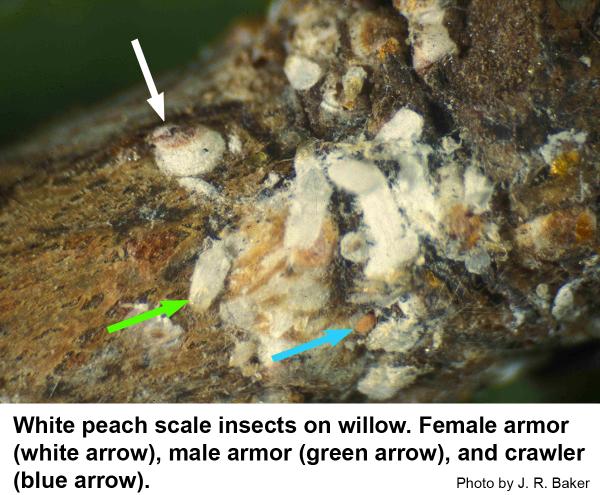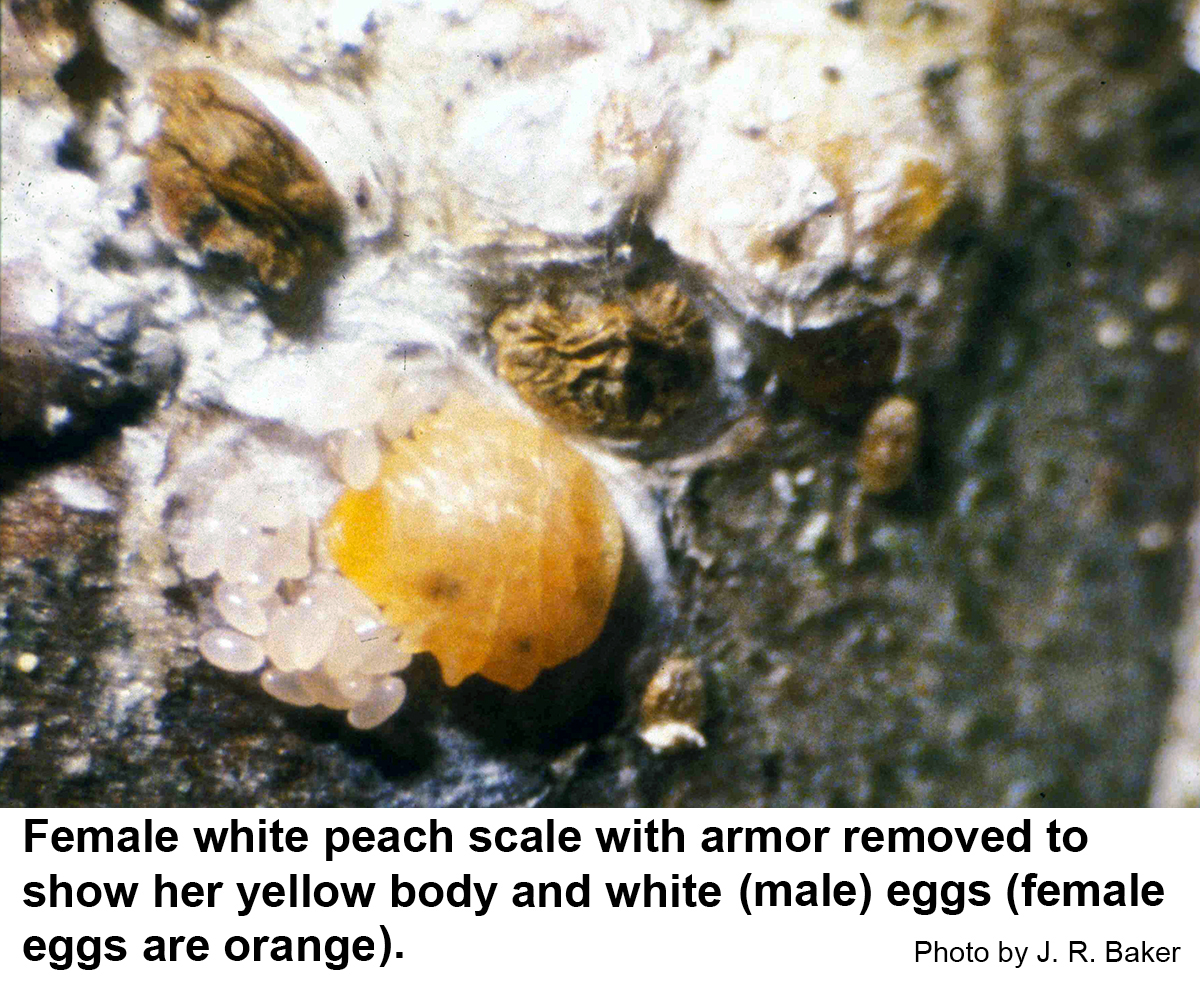Description and Biology
White peach scale insects, Pseudaulacaspis pentagona, are so called because female armor is white; the males secrete a noticeable amount of a white, fluffy residue, and these scales are often found on peach. The armor of females is fairly round with a yellowish spot in the middle (the cast skins of earlier stages). Male armor is narrow, ridged, and snow white. The cast skin of an earlier stage appears at the head end of the male scale. Females lay 80 to 100 eggs under their armor. Male eggs are white and female eggs are orange. The males are tiny gnat-like insects that crawl or fly to find mates or die trying (they have no mouthparts and cannot feed but they do have four eyes!). About 12 days after mating, females lay their eggs and eventually die. The eggs hatch in three or four days in warm weather, and the young scales wander about for about 12 hours before settling down to feed. White peach scale has at least three generations each year in North Carolina. The crawlers of white peach can be present in low numbers throughout the year, but there are three distinct "peaks" of crawler emergence in early May, mid July, and early September. When populations become dense, females lay mostly male eggs. By then plants appear to have been flocked and the stems may be solid white.
Host Plants
White peach scale insect is a pest of peaches and related trees as well as lilac, ligustrum, mulberry, walnut, other woody plants as well as soybeans, potato, and papaya. Wallace Dekle listed more than 100 host plants for white peach scales. White peach scale can be quite damaging to its host plants. Infested plants may be stunted and may die back. Sometimes heavily infested plants are completely killed.
Residential Recommendation
White peach scales have two very effective natural parasites: Encarsia berlesi and Aphytis proclia. However, sometimes these parasites can't give acceptable supression. Because the white peach scale is an armored scale insect, it would be good to use one of the horticultural oils for control. These oils can be used at a growing season rate from late spring until late December or can be used at a dormant spray during the winter to reduce the overwintering population. Dr. John Meyer of this department did some experiments with white peach scale control some years ago and found oil does, indeed, suppress white peach scales. It is probably best to apply the oil, wait two or three weeks and apply it again. If a tree is too large to spray, a second strategy is to wait until early May and have Safari applied by a licensed landscaper. Such a soil treatment (some formulations of Safari are specifically labeled for armored scale management) should give at least 12 months of control.
References
- Armored Scale Identification and Management on Ornamental Plants. Frank, S. 2010. Entomology Insect Notes, NC State Extension Publications.
- Common name: white peach scale, scientific name: Pseudaulacaspis pentagona (Targioni) (Insecta: Hemiptera: Diaspididae). Branscome, D. 2012 (revision). Entomology & Nematology, FDACS/DPI, EDIS.
- Effect of dormant oil treatments on white peach scale (Homoptera: Diaspididae) and its overwintering parasite complex. Meyer, J. R. and C. A. Nalepa. 1991. J. Entomol. Sci. 26 (1): 27-32.
- Florida Armored Scale Insects. Dekle, G. W. 1965. Arthropods of florida and Neighboring Land Area Vol. 3. Florida Dept. Agr. Div. Plant Industry. 265 pp.
- Insect and Related Pests of Shrubs. Baker, J. R. ed. 1980. NC Agricultural Extension Service publication AG-189. 199 pp.
- Extension Plant Pathology Publications and Factsheets
- Horticultural Science Publications
- North Carolina Agricultural Chemicals Manual
For assistance with a specific problem, contact your local N.C. Cooperative Extension Center.
This Factsheet has not been peer reviewed.
Publication date: Oct. 17, 2013
Revised: Jan. 7, 2023
N.C. Cooperative Extension prohibits discrimination and harassment regardless of age, color, disability, family and marital status, gender identity, national origin, political beliefs, race, religion, sex (including pregnancy), sexual orientation and veteran status.



